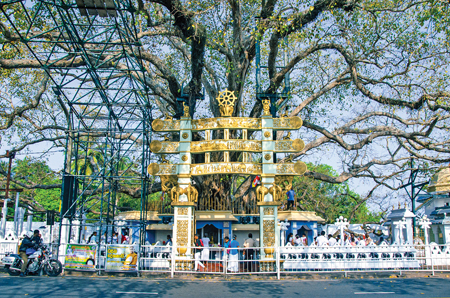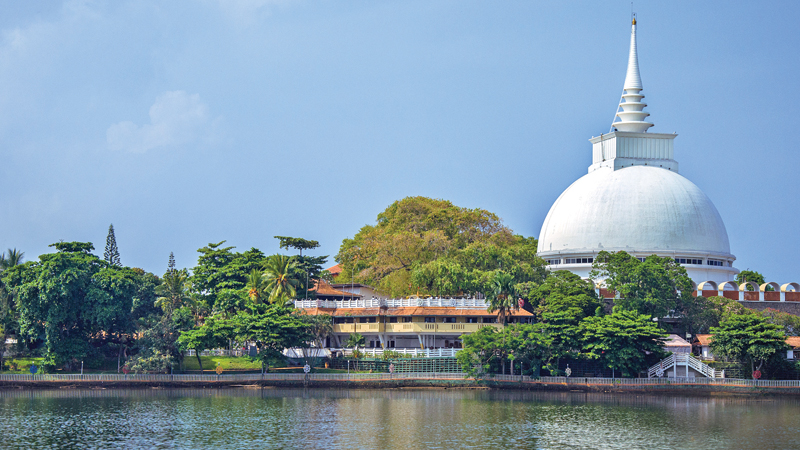 My first encounter with the Kalutara Bodhi took place in the 1970s when I was a young boy at Botalegama which is a remote village in Bulathsinhala in the Kalutara district where I was born and grew up. When the Kapilawasthupura Relic exposition was held in the Kalutara Bodhi premises in the late 1970s, as children we were taken by our parents to see these sacred relics which were flown here from India.
My first encounter with the Kalutara Bodhi took place in the 1970s when I was a young boy at Botalegama which is a remote village in Bulathsinhala in the Kalutara district where I was born and grew up. When the Kapilawasthupura Relic exposition was held in the Kalutara Bodhi premises in the late 1970s, as children we were taken by our parents to see these sacred relics which were flown here from India.
Kalutara is 45 kms away from Colombo on the main Galle road on the A2 highway. If you travel South on the Galle road passing Kalutara, it will be hard to miss the famous Bodhi tree which greets you at the entrance to the town. If you travel in a vehicle, your driver will pull up near the tree and alight to drop a few votive coins. While Sri Lankan Buddhists who go past the Bodhi tree at Kalutara would break journey briefly to make an offering of a few coins and make a wish for a safe journey and eternal bliss after life, travellers of most other faiths too have now acquired the habit of treating the much-venerated tree with reverence. The Bodhi tree at Kalutara is met as you cross the twin spans of the bridge across the Kalu Ganga, which flows into the sea from nearby. With the Galle road being Sri Lanka’s busiest trunk route, the shrine near the Bodhi tree is always full of devotees. Busloads of pilgrims often come to worship the sacred place, as do the passengers of many other vehicles.
Offerings at sacred site

The Sanchi Thorana at the entrance to the Bodhi tree on the lower terrace
The Buddhists offer flowers at the shrine, Dagaba and the Bo-tree, hang prayer flags on the fence around the tree, whose hanging branches are supported by many props erected to bear their weight. Some pour offerings of milk or water to the tree, in fulfilment of vows. Some meditate in its shade. Three times a day, at dawn, pre-noon and dusk, drums are beaten and temple music heard when special offerings are made to the Buddha and the sacred tree.
The Bodhi tree (Ficus religiousa) at Kalutara, popularly known as the ‘Kalutara Bo-tree’, is believed to be one of 32 saplings miraculously sprang from fruits of the famous Sri Maha Bodhi – the Great Bodhi Tree -when it was planted in Anuradhapura more than 2,200 years ago. The ancient chronicles of the Sinhalese record that the saplings were planted at several sites throughout the island, and Kalutara was one of them.
The Sacred Bodhi Tree in Anuradhapura – the oldest historically documented tree in the world – is venerated by Buddhists because it has grown from a branch of the tree under which the Siddartha Gautama meditated till he attained enlighten¬ment, the Buddhahood. The original tree at Bodhi Gaya, in India, does not exist. While this association of the Bodhi tree with the Buddha is the cause for its being held in veneration by Buddhists, the Bo-tree at Kalutara is held in special reverence because of its link with the Sacred Tree in Anuradhapura, and the belief among many Sri Lankan Buddhists that it has certain supernatural powers.
Kalutota – a port of the Kalu Ganga – became Kalutara over the years. The British considered it the Richmond of Ceylon due to its picturesque location on the banks of the meandering Kalu Ganga, where it flows into the sea.
Seat of government
In the early 11th Century, a South Indian Prince, Vikramapandiya, had come to Ruhuna for fear of the Chola invaders and made Kalutara his seat of government. He built a palace – Gangatilake Maligawa which was later destroyed by floods. He had also planted a Bo-tree on a hillock on the palace ground.
In the 15th Century, the Gangatilake Vihara (temple) was built at the same location by a ruling monarch – Sangabodhi Buwanekabahu. Later in the 16th Century, the Portuguese Governor Jeronimo de Asavedo confiscated the land of the temple, ransacked and levelled the temple to the ground. However, the Bo-tree was spared. But the Portuguese made the site out of bounds to pilgrims. Neglected through the years, the Bo-tree was in a poor state with a wooden enclosure and a crumbling brick foundation.
In the early years of the 20th Century, Cyril de Zoysa a lawyer of Kalutara, took upon himself to build a protective wall round the Bo-tree and an altar for offerings like flowers and incense. When the British Government Agent who lived in his residence next to the Bo-tree complained against the beating of drums and attempted to destroy the tree, de Zoysa intervened.
He did not rest till he got the Government Agent ejected from his residence and used the land to improve as part of the sacred precincts of the Bo-tree. He acquired the adjoining administrative building and converted it to a preaching hall. He also installed collection tills by the side of the busy main road. Cyril de Zoysa who became a prominent figure in politics and Buddhist affairs and was honoured with a knighthood by the British, had a second Bo-tree by the side of the road, protected by a parapet wall and built a small a bell shaped (Gantakara) dagaba by its side. This was for the convenience of worship for travellers.
Money offering ritual
The crew members of the transport service Sir Cyril owned, were instructed to stop at the Bo tree and offer Panduru (money offered to show one’s veneration). As a result, today, this has become a ritual of almost every traveller of varied religions, who passes this Bo -tree.
People of Kalutara say that one employee of Sir Cyril’s transport company having been dismissed from service for disregarding his instructions, joined another transport service. He who had defiantly driven the bus past the Bo-tree without stopping for the ritual offering, crashed into a lamp post before he could proceed a few yards from this spot. This incident strengthened the belief many held of the supernatural power of this venerated tree.
A Stupa of 180 feet tall was constructed sheltering a smaller bubble shaped dagaba by the ancient Bo-tree.
The protective granite wall built around this Vatadoseya (a shelter built over a stupa) has four miniature dagabas at the four corners and flood lights lighting up this glittering white bubble shaped shelter. It is a magnificent and novel construction with flights of steps leading up to a shrine room with four gold painted Buddha statues round the inner dagaba.
Seventy-five murals depicting the Buddha’s Samsaric journey decorate the inner walls of this structure – from Siddartha’s first incarnation as a bodhisattva to his birth as Siddhartha Gautama and the attainment of Enlightenment. The inside of the dagaba is also an echo chamber. A statue of Sir Cyril de Zoysa stands on one side of this Vatadaseya built by grateful townspeople in remembrance of his tireless work.









